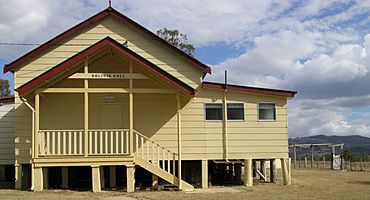Bolivia, New South Wales facts for kids
Quick facts for kids BoliviaNew South Wales |
|
|---|---|

Bolivia Hall with Bolivia Hill in the background
|
|
| Population | 66 (2016) |
| Postcode(s) | 2372 |
| Elevation | 830 m (2,723 ft) |
| Location |
|
| LGA(s) | Tenterfield Shire |
| County | Clive County |
| State electorate(s) | Lismore |
| Federal Division(s) | New England |
Bolivia is a small place in the New England region of New South Wales, Australia. It is located on the Northern Tablelands. Today, you can find the old Bolivia Hotel, a disused post office, a former railway siding, and a community hall there. Bolivia is known for its beautiful natural areas and interesting history.
Contents
Discover Bolivia's Past
First People of Bolivia
The land where Bolivia is located first belonged to the Ngarabal people. In their language, the area was called Bilba. This means "big bushes." This place has always been very important to the Ngarabal people. It has special sacred sites and ceremony grounds. Records show that about 300 Aboriginal people held a traditional gathering called a corroboree here in the 1870s.
Early European Settlers
The first European settlement began in 1840. A sheep farm was started by a man named Edward Hurry. He had lived in Bolivia in South America before. That's why he named his new property "Bolivia."
Later, in the 1840s, Edward Irby bought the Bolivia property. The Ngarabal people resisted the new settlers coming onto their land. There were conflicts between them.
How Bolivia Grew
In the 1880s, a small town started to grow near Bolivia Hill. This happened when the railway line was built through the area. The town had many businesses. There were two bakeries, two butcher shops, and two general stores. It also had a post and telegraph office. The railway had its own offices, a workshop, and stables.
The first school in Bolivia opened in 1883. It closed a few years later. Other schools opened over time, with one operating until 1966. The Bolivia Post Office opened in 1883 and closed in 1982.
In 1981, the name Bolivia was officially given to the area. It now serves as an address for the farms nearby. These farms are located north and northeast of Deepwater.
Historic Buildings and Mining
The old Bolivia Hotel is a very important building. It is listed on the Register of the National Estate. This building was built around 1840-1860. It was first used as a changing station for Cobb & Co coaches. These coaches needed fresh horses every 10 to 25 kilometers. Passengers could also eat or stay overnight at these stations. Later, the building was a post office and a boarding house.
The Bolivia School of Arts building was built in 1914. The land for it was given by A.M. White. Many different minerals have been found and mined in this region. These include bismuth, gold, tin, silver, and silica.
The Bolivia Cemetery was opened in 1884 and closed in 1986. It was used regularly until about 1900. Today, there are no headstones left. Only a few plants and dips in the ground show where it once was.
Bolivia's Natural Landscape
Bolivia is located north of Deepwater Creek. It also sits along both sides of Splitters Swamp Creek. The area has many rough granite rock formations. Little Bolivia Hill is about 80 meters tall. It rises above Deepwater Creek on the southern edge of Bolivia.
Unique Plants of Bolivia
Bolivia Hill and its nearby nature reserve are special places. They are the only known homes for several rare plants. These include the Bolivia Hill Boronia (Boronia boliviensis), Bolivia Homoranthus (Homoranthus croftianus), and Bolivia Stringybark (Eucalyptus boliviana). You can also find the Bolivia Hill Pimelea (Pimelea venosa) and the Bolivia wattle (Acacia pycnostachya) here.
Fun and Games in Bolivia
In the past, people in Bolivia enjoyed many sports. These included tennis, cricket, and pigeon shooting. Polo and horse racing were also very popular activities.
What Bolivia Produces Today
Today, the main industries in Bolivia are growing wine and raising beef cattle. In 2001, a Red Angus bull from Bolivia was sold for a record price in Australia. It sold for $17,500.
Bolivia Railway Station
| Preceding station | Former Services | Following station | ||
|---|---|---|---|---|
| Sandy Flat
towards Wallangarra
|
Main North Line | Deepwater
towards Sydney
|
||
Images for kids



